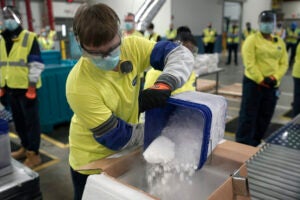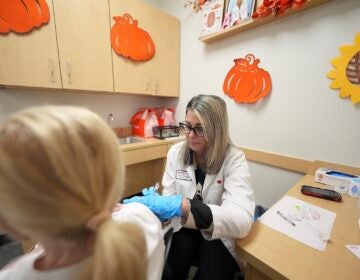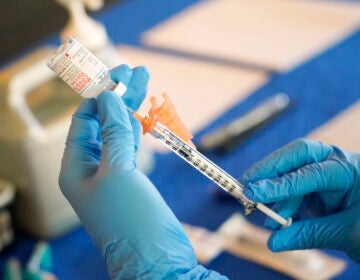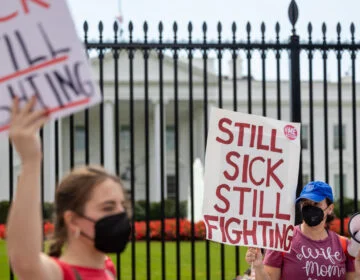What will the end of the COVID pandemic look like?
It’s been more than a year of physical distancing and change. WHYY’s Health Desk Help Desk asked when, and how, life will resume post-pandemic?
Listen 5:54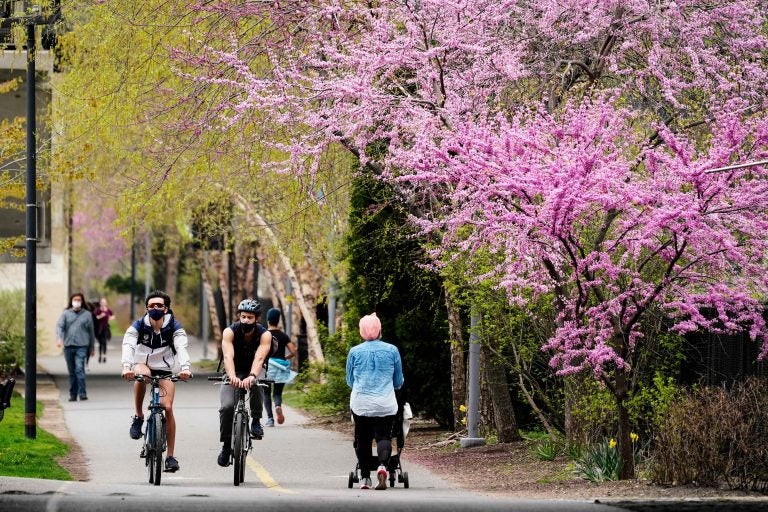
People wearing face masks as a precaution against the coronavirus move along the Schuylkill River Trail as tree blossoms with spring colors, Wednesday, April 14, 2021, in Philadelphia. (AP Photo/Matt Rourke)
This is one of a series of articles in which reporters from WHYY’s Health Desk Help Desk answer questions about vaccines and COVID-19 submitted by you, our audience.
Ian Snyder is 25, and overall he’s not at high risk for COVID-19. But he didn’t take any chances this past winter. He didn’t see his parents for months, because he was worried about spreading the coronavirus to them.
Now fully vaccinated, Snyder was able to visit them over Passover — and it was “incredible,” he said. But though he’s protected from the virus, he’s not entirely sure how to get back to normal life.
“The hardest part has just been learning to fear the presence of other people and having to unlearn that fear. I think that’s the piece that I’m really still untangling internally,” Snyder said.
“I think I’m still coming to understand what it means for me … while understanding that we are very much not in the clear on a wider scale yet.”
More than 50% of adults in the United States have received at least one dose of the COVID-19 vaccine. For many, it feels like the light at the end of the tunnel. But after more than a year of physical distancing and lifestyle changes, people want to know when — and how — life will resume post-pandemic.
What will the end of the pandemic look like? | When will we reach herd immunity? | When will COVID-19 finally go away? | How do I decide what’s safe and what’s not?
There’s been a lot of discussion about how society will react to the end of the pandemic. Many predict life will reflect the Roaring ’20s, because people are desperate to socialize after a year of physical distancing. Others predict that won’t be so easy because life has been forever changed. Some contemplate whether society will become accustomed to isolation and whether people will have to re-learn social skills. And psychologists say anxiety induced by the pandemic will likely continue. The fear of catching COVID-19 won’t vanish overnight, they say.
Behavioral scientists say it’s difficult to forecast this with certainty because human behavior is complex.
“The first tendency is that when we have a pent-up demand for something, once we’re allowed to do it, we sort of do it with exuberance. When barbershops and salons first opened up after the initial lockdown, there was more desire for haircuts than there would be in a typical week because we all have that pent-up desire,” said Gretchen Chapman, a psychology professor at Carnegie Mellon University.
On the other hand, humans are creatures of habit, she said.
“When we do things a certain way for a long time, we get in the habit of doing it that way and it’s uncomfortable to do it another way,” Chapman said. “So if we’re used to working at home, then it’s a big transition to go back to the office. Or we’re used to just doing things with our own family, then it’s a big transition to get together with other friends.”
Whatever a person feels is valid, she said, and it’s the responsibility of health experts to guide people about which activities are safe and which aren’t as more and more people are vaccinated.
“People shouldn’t have to figure out what behaviors they can do versus behaviors that they shouldn’t do yet — that’s the job for the experts. And then the challenge for the experts is how to communicate that clearly in a way that leads people to understand, that doesn’t have some unintended consequences of their message,” Chapman said. “Just simple rules that are easy to follow and that are pretty good approximations to whatever perfect standard the experts have in mind.”
Is herd immunity the answer? And how do we reach it?
Public health experts say that for life to get back to normal, the country needs to reach herd immunity. Herd immunity, or community immunity, is achieved when a large percentage of the population can’t get sick, and therefore the virus can’t spread. The more people are vaccinated, the less likely the virus will spread.
It’s not certain what percentage of the population needs to be vaccinated against COVID-19 to reach herd immunity. But many medical experts estimate that it’s 70% to 80%.
That can be complicated by other things too, such as new variants of the virus, said Neal Goldstein, an epidemiologist at Drexel University’s Dornsife School of Public Health.
“What complicates all of this is the idea that there may be variants that emerge over time — we would call these vaccine escape variants, when your immunity that you have may not confer complete or a sufficient amount of immunity,” he said. “But then we also don’t know exactly how long immunity lasts. And immunity may last for a different period of time for different people, based on whether they received a vaccination or whether they got sick and got immunity that way. So there’s just so many different balls up in the air right now.”
Will COVID-19 disappear?
Unlike diseases such as polio and smallpox, which have been eradicated in the U.S. through vaccines, COVID-19 won’t be eliminated completely — it’s already too widespread and too transmissible. But it’s slowly becoming more manageable with increased testing, improved treatment, and a rise in vaccinations.
“The consensus in the scientific community seems to be that this virus will go endemic. In other words, it’ll be kind of a seasonally circulating virus that will live alongside the other coronaviruses,” Goldstein said.
In the future, people might treat COVID-19 like the flu, he said. Scientists have suggested that “booster shots” of the COVID vaccine might be necessary, and the CEO of Pfizer recently announced it’s likely people will need that booster within a year of full vaccination.
“There’s no light switch that’s turned on and off to say, pandemic or no pandemic. Essentially, what we’re seeing is the evolution of a virus … that’s happened for essentially the entirety of however long viruses have been around for,” Goldstein said.
What will reopening society look like? And what will be safe?
Chapman said that, in general, risk assessments are personal. People are often more influenced by anecdotes than by big datasets, and by their personal life experiences than by global statistics.
She said it’s fair to estimate that people might evaluate which activities are safe by following what their friends are doing.
“We tend to do the same thing as the people close to us on our network. And part of that is not one person influencing the other. It’s just people who have similar views already tend to congregate together, the birds of a feather flocking together phenomenon,” Chapman said.
“But there is also evidence of the propagation phenomenon, where one person’s beliefs or behavior will influence the beliefs and behavior of other people that are close to them in the social network.”
Tess Wilkinson-Ryan studies the psychology of legal decision-making and is a professor of law and psychology at the University of Pennsylvania. She believes people will continue to be cautious until the majority of the country is vaccinated. While being vaccinated can prevent serious illness, it is not foolproof, however.
“I think that, especially after a year of taking COVID extraordinarily seriously, it’s hard to think of even a small risk of COVID as being no big deal,” Wilkinson-Ryan said.
“I also think we have all developed a bunch of habits where some of the things we do are both because we’re being cautious about COVID itself, but are also elaborate ways of signaling to others that we want to be respectful of their space, respectful of their own sort of hygiene practices and boundaries,” she said. “I think as long as we’re in this middle-ground stage where some people are vaccinated and some people are not, we’ll probably continue to see the sort of social function of some of these hygiene practices remain.”
She said it’s OK for people to still have anxieties about getting back to normal, and that they should not question if their fears are valid.
“I don’t know that most people have even processed how extraordinary this year was, how extraordinary the demand placed on individuals has been. And so it seems to me that everybody should get this enormous grace period for trying to figure out what’s OK with them,” Wilkinson-Ryan said.
“People may have found that other priorities and sensibilities may have shifted. Some people may have had an epiphany about what they want the structure of their social and personal life to look like,” she added. “I think it’s really tempting to think that this is going to be like a light switch and we’re going to turn it off and go back to normal. But I’m not sure people have exactly reckoned how destabilizing this experience has been.”
Wilkinson-Ryan said it should not be socially acceptable for those who are ready to “get back to normal” to force risk-tolerating behaviors on those who are cautious.
People should expect that there will be some social awkwardness after the pandemic, Chapman of Carnegie Mellon said, because people have had fewer in-person interactions for more than a year.
“My guess is that it is going to affect at least some of us, that we’ve lost certain social skills about eye contact and staying the right distance away from each other — not for pandemic reasons, but so that you’re close enough to be friendly, but not so close that you’re sort of in the person’s personal space — all of those bodily aspects of the interactions we haven’t had practice with,” Chapman said.
“And those things come more naturally for some people than others. I would predict that as we get back into in-person interactions, more routine, that there’s going to be more awkwardness or socially inappropriate behavior until we sort of relearn all of that.”
In the past, Americans were quick to give friends, acquaintances, and loved ones a hug upon seeing them. After the pandemic, society will have to learn to ask if that’s OK, Chapman said.
As for Snyder, he’s giving it time until he feels normal again.
“I think it’s [just] untangling the learned behaviors and trauma of the last year … in my body and the way my body reacts to other people,” he said. “It’s nice to be walking around and not [be] just, like, constantly hyper-vigilant. That is — that was — exhausting.”

Get daily updates from WHYY News!
WHYY is your source for fact-based, in-depth journalism and information. As a nonprofit organization, we rely on financial support from readers like you. Please give today.



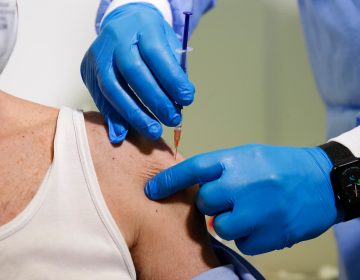
![CoronavirusPandemic_1024x512[1]](https://whyy.org/wp-content/uploads/2020/03/CoronavirusPandemic_1024x5121-300x150.jpg)
